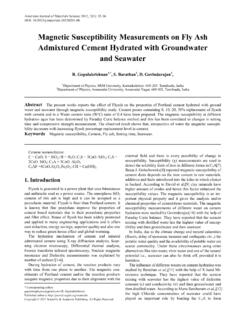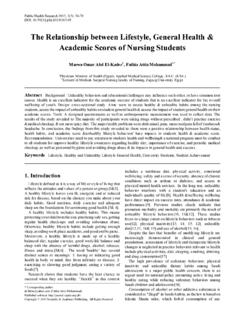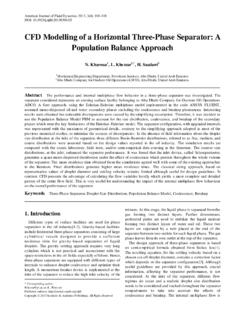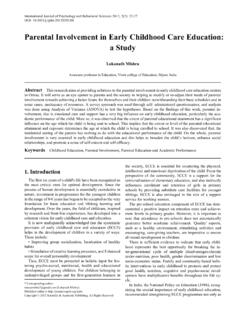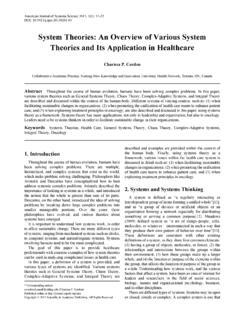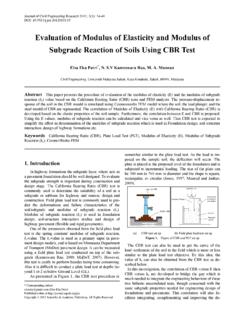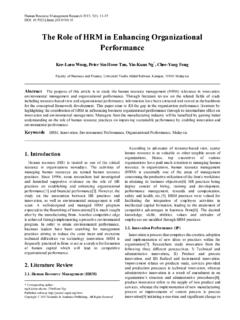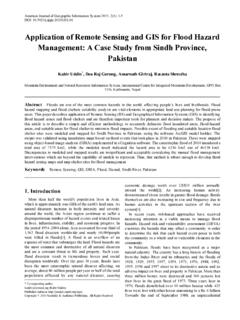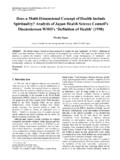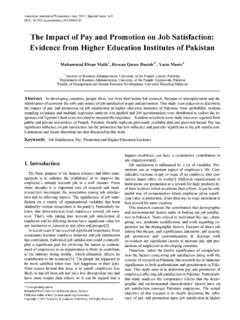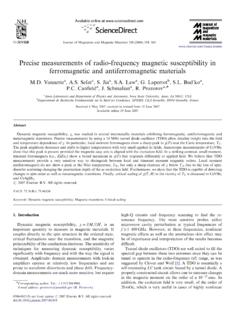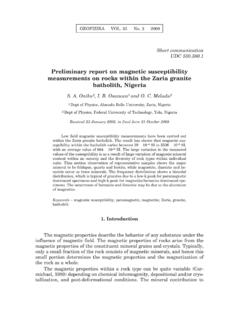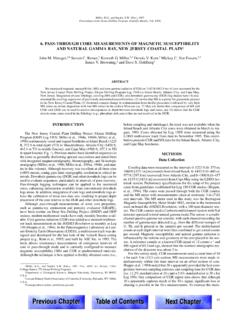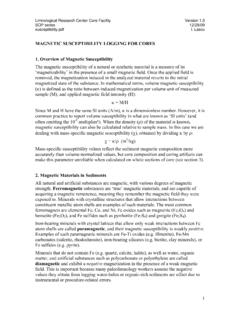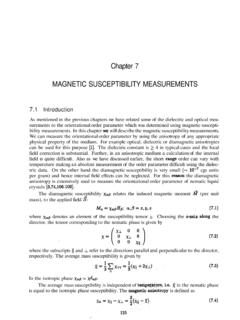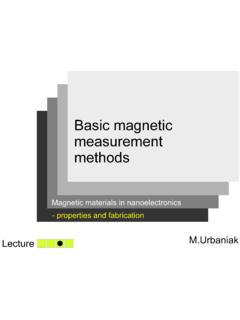Transcription of Magnetic Susceptibility of Coordination …
1 Journal of Laboratory Chemical Education 2014, 2(2): 11-14 DOI: Magnetic Susceptibility of Coordination Compounds in the General Chemistry Laboratory Lauren McMills*, Frazier Nyasulu, Rebecca Barlag Department of Chemistry and Biochemistry, Ohio University, Athens, OH 45701 Abstract A general chemistry laboratory exercise is described in which the number of unpaired electrons in Coordination compounds is determined. The compounds are Na2 PdCl4, K4Fe(CN)6, Cr(acac)3, Na3 FeF6, Co(acac)3 and Mn(acac)2. These compounds are presented to students as Na2 PdA4, K4 FeA6, CrB3, Na3 FeA6, CoB3 and MnB2 respectively where A is monodentate, B is bidentate and both ligands have a charge of 1.
2 For a Coordination number of six an octahedral structure is assumed, and for a Coordination number of four, tetrahedral and square planar structures are assumed. After determining the number of d-level electrons, students select applicable energy level diagrams and assign electrons in all possible arrangements consistent with Hund s rule. Students cross out inappropriate diagrams, providing an explanation for why they have done so. By comparing the number of unpaired electrons determined using Magnetic Susceptibility and with the remaining diagrams, students deduce the structure and spin arrangement(s) that fit the experimental results. In about half of the cases, the structure is conclusively determined.
3 Keywords Magnetic Susceptibility , Coordination compounds, First year, Undergraduate, General chemistry 1. Introduction Although the pedagogical value of Magnetic Susceptibility measurements is well known, the cost of commercial Magnetic Susceptibility instruments limits their use. Some forgo commercial instruments and make their own instruments. [1-9] Recent publications usually describe simple inexpensive ways to build Magnetic Susceptibility instruments and results are presented mostly to show that the instrument works. Institutions that have commercial Magnetic Susceptibility instruments primarily use them in inorganic [10] and physical chemistry [11] where the numbers of students are typically low, so a limited number of instruments suffice.
4 These instruments, homemade or commercial, can be particularly useful in general chemistry because it is here that students first learn electron configurations of atoms, ions and simple molecules, as well as learn to predict the number of unpaired electrons in various substances. Magnetic Susceptibility in general chemistry labs is rare and one of the goals of this paper is to advocate for their use. If commercial instruments are used at this level, one of the challenges is how to accommodate a large number of general chemistry students with a limited number of instruments. The Evans type MSB-1 Magnetic Susceptibility balances * Corresponding author: (Lauren McMills) Published online at Copyright 2014 Scientific & Academic Publishing.
5 All Rights Reserved are easy to operate, robust and portable. These are very valuable attributes for an instrument handled by hundreds of students and requiring the instrument to be moved multiple times in a single day. This lab exercise focuses on Coordination compounds, and is therefore appropriate after transition elements and Coordination compounds have been covered in lecture. Although the measurements take a short time, the entire lab (prelab lecture, data collection, data analysis and conclusion) takes an average of three hours. This paper also describes the strategies that have been used working with one, two and three MSB-1 Magnetic Susceptibility balances while serving ~600 students.
6 This lab can also be performed using any equipment (homemade or otherwise) that can be used to determine the number of unpaired electrons in Coordination compounds. In this exercise, the compound or complex ion is classified as a six-coordinate (octahedral structure is assumed) or four-coordinate species (tetrahedral or square planar structure is assumed) based on the number of ligands and the Coordination number of the ligand. After determining the number of d-level electrons in each transition metal ion, participants select an energy level diagram applicable to the structure, and assign the d-level electrons allowing for all possible arrangements consistent with Hund s rule.
7 Students then consider the diagrams they have drawn and with explanation, cross out any inapplicable diagrams. For example, a low spin assignment for the tetrahedral structure would be crossed-out because in this case the crystal field splitting energy ( t) can be expected to be lower than the pairing energy (P). Considering the number of unpaired 12 Lauren McMills et al.: Magnetic Susceptibility of Coordination Compounds in the General Chemistry Laboratory electrons that are determined experimentally (N), students find which of the remaining arrangements fit. The identity of the ligand is not provided to the students; ligands are labeled A or B depending on whether they are monodentate or bidentate and both have charges of 1.
8 Information provided to students also includes the molar mass and counter ion molar Magnetic Susceptibility (XM) correction values, see Table 1. On the day of the lab, students first attend an hour long pre-lab lecture in which the theory and the operation of the Magnetic Susceptibility balance are described. These are described in the Supplementary Information. Samples are pre-packed for the students because: (i) At a cost of $20, sample tubes are expensive. (ii) Sample loading requires tapping of loaded sample tubes on a hard surface until the Magnetic Susceptibility reading becomes constant.
9 Sample tubes are fragile therefore many would be broken. (iii) It is hard to empty a tube that has been previously loaded meaning that new tubes would need to be used each time. 2. Theory The theory and operation of MSB-1 Magnetic Susceptibility balances have been described in a number of publications. [9,10] The MSB-1 balance reports a value of R. The molar Magnetic Susceptibility (XM) is calculated according to the formula: (1) where: MM is the molar mass in grams/mol C is the calibration constant L is the sample length in the sample tube in cm Ro is the R value recorded with an empty sample tube m is the mass in grams After correcting for diamagnetic components (counter ions and ligands) [10], the corrected molar Magnetic Susceptibility of the sample is calculated (XMc ).
10 Considering a paramagnetic substance, the number of unpaired electrons (N), XMc and the Kelvin temperature (T) are related by the equation: N2 2N 8 XMcT(K) = 0 (2) Solving this quadratic equation provides the number of unpaired electrons, N. We require students to complete an Excel spreadsheet; students have to program their own calculations. The spreadsheet is advantageous over the use of a nonprogrammable calculator because there are a significant number of identical calculations. The spreadsheet also allows students (and their instructors) to double check their entries as well as their formulas.
